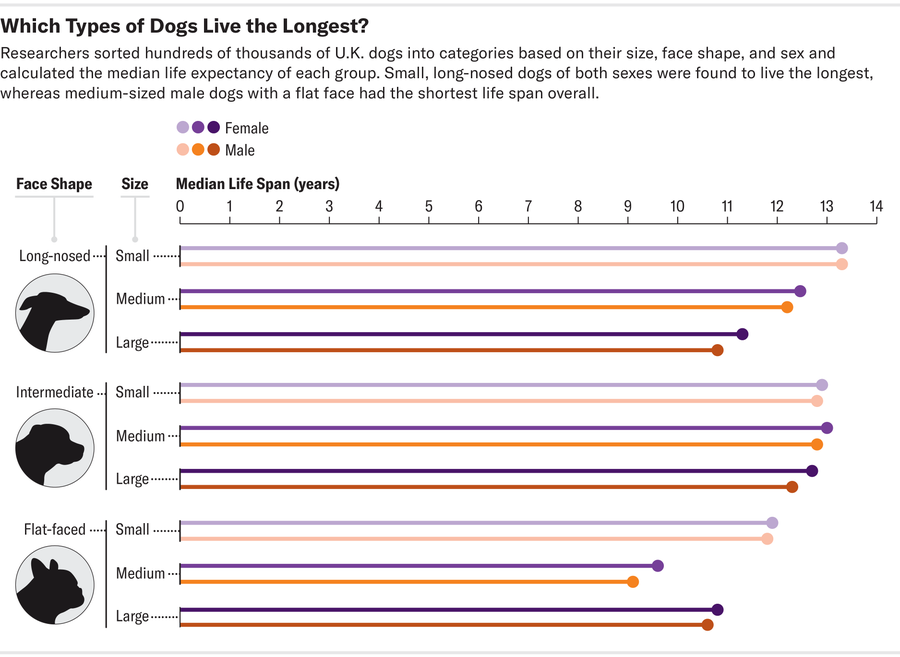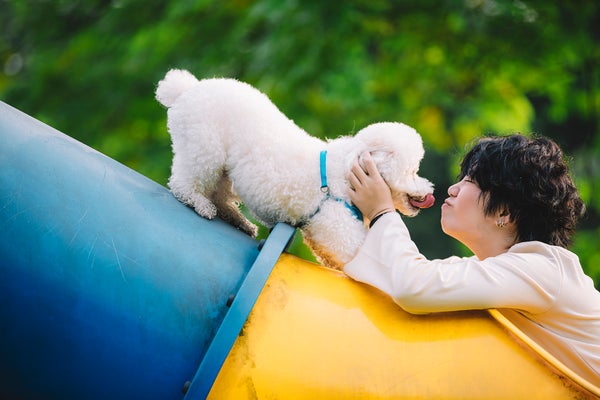Every dog has its day, but some dogs get more days than others. Toy poodles can live 18 years or more, while the average Great Dane is lucky to live half that long. This large discrepancy in the life spans of animals within a single species is uncommon, yet scientists aren’t sure which traits help certain dog breeds outlive others.
Researchers in England recently set out to determine what impacts canine life expectancy. The team amassed a dataset of more than 580,000 domestic dogs of more than 150 different breeds in the U.K. Their findings, published on Thursday in Scientific Reports, reveal that traits such as size, sex and head proportion are likely to have a large impact on how many years of life a certain canine has.
“If you have a medium-sized, flat-face male dog, like an English bulldog, it’s nearly three times more likely to live a shorter life than a small-size, long-face female of a breed like a miniature dachshund or an Italian greyhound,” says Kirsten McMillan, a data scientist at Dogs Trust, the largest canine humane society in the U.K., and lead author of the new study.
On supporting science journalism
If you're enjoying this article, consider supporting our award-winning journalism by subscribing. By purchasing a subscription you are helping to ensure the future of impactful stories about the discoveries and ideas shaping our world today.
Over the past 16,000 years, humans have made the domestic dog (Canis lupus familiaris) into one of the most widespread and diverse species on the planet. Today there are more than 400 genetically distinct breeds, ranging from pint-size Pomeranians to massive mastiffs. With such different body types and lifestyles, it makes sense that dogs of different breeds would fare differently as they aged.
Past work has revealed a few broad trends: female dogs tend to fare better than males, and smaller breeds tend to outlive larger ones. There is also growing evidence that popular flat-faced breeds such as bulldogs and pugs experience greater health complications linked to breathing issues and skin conditions, compared with breeds that have a longer muzzle.
To determine what was impacting the longevity of dogs in the U.K., McMillan and her colleagues at Dogs Trust set out to compile a giant database of local dogs, including their breed and sex and lifespan. The researchers gathered information from 18 different sources, including breeding registries, humane societies, veterinary practices, pet insurance companies and academic institutions. In total, they assembled records of 584,734 dogs of 155 different breeds. Those that did not fit cleanly into a single breed were classified as a crossbreed.
Once the team compiled the data, they calculated the median life expectancy for each breed and built a phylogenetic tree to determine how closely different breeds were related to one another. This helped the team determine which breeds were at the highest risk of an early death and whether traits such as size, head shape and sex potentially impact a dog’s longevity.
While the team was unable to pinpoint direct risk factors for an early death, they discovered several intriguing trends. One was that female dogs across all breeds tended to outlive male ones: the median life expectancy of the females was 12.7 years, and that of the males was 12.4 years. Pure breeds’ median lifespan of 12.7 years was also slightly longer than that of crossbreeds: 12 years.
The shorter lifespan of crossbreeds was slightly surprising to Audrey Ruple, a veterinary epidemiologist at Virginia Tech, who was not involved in the new study. “We often assume that there is an advantage for crossbred dogs because they’re less likely to have a genetic predisposition to particular types of disease,” she says. The fact that purebred dogs outlived more vigorous hybrids may be partially linked to the increased resources many owners put into caring for expensive pure breeds.

The researchers were also able to determine which breeds were prone to dying young and which ones lived longer. Smaller, longer-nosed dogs such as Shetland sheepdogs or whippets had the longest life expectancy, with a median of 13.3 years. On the other end of the spectrum were medium-sized dogs with a crumpled mug such as bulldogs. Their median life expectancy was 9.6 years for females and only 9.1 years for males.
Size and head shape may help explain why certain breeds had a higher risk of an early death (French bulldogs, bloodhounds, Saint Bernards), whereas others had a much lower one (Lancashire heelers, Shiba Inus, border terriers). There were notable exceptions to this trend, however. While many flat-faced dogs fared poorly, others were relatively long-lived. For example, Tibetan spaniels could live to the ripe age of 15.2 years, an extremely old age for a dog with their flattened facial proportions.
The researchers stress that these results are solely linked to dogs in the U.K. Though the paper’s methodology is easy to apply to other populations of dogs, the U.K.’s canine population is not representative of dog demographics around the world and may be slightly skewed for breeds that are more popular across the pond from the United States. “We don’t have [a] dogs census, so we don’t really know how equivalent dog populations are in different countries,” Ruple says. “I think we might see similar results [to the new study] on a large scale.”
Furthermore, future efforts could better incorporate data on popular “designer” hybrids such as labradoodles. Such crosses between different pure breeds may outlive the run-of-the-mill mutt and potentially even purebreds. But McMillan hopes the new work will help regulators ensure healthy breeding measures—and help prospective dog owners understand what they are getting into when they acquire a certain breed of dog.
“I want people to use this paper as a platform for improving the lives of companion dogs,” McMillan says. “This is not a doggy doomsday piece.”
